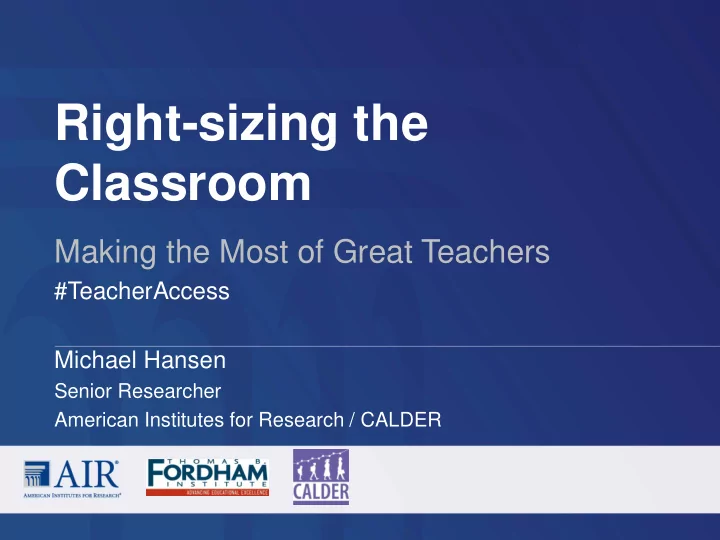

Right-sizing the Classroom Making the Most of Great Teachers #TeacherAccess Michael Hansen Senior Researcher American Institutes for Research / CALDER
What if…we tried playing to our strengths in schools? Typical method Class-size shifting 2
Prior research tilts toward teachers Teacher Quality Class Size Large impacts on students Small impacts, that are across multiple contexts near zero in some contexts • Significant results across subjects • Largest in lower grades, initial and grades, though sizes vary exposure Good teacher = extra ¼ to Equivalent impact of 10 to ½ year of learning 20 student reduction in class size Sources: Hanushek and Rivkin, 2010; Nye, et al., 2004; Whitehurst and Chingos, 2011. 3
Data & Methods North Carolina data • Grades 5 and 8; Math, Reading and Science test scores • Four years of data Focus specifically on schools where students can be reallocated across teachers • Approximately 90% of NC students are in such schools In 2010/11 target year: • Document current patterns of sorting occurring in NC • Simulate classroom assignments that could arise under strategic assignment; calculate student learning gains and access to effective teachers 4
Target Year Current Assignments Table 2. Snapshot of Observed Class Size Assignment in North Carolina Grade 5 Grade 8 Math Reading Science Math Reading Science Average class-size deviation within 2.738 3.073 1.743 5.587 5.689 3.816 school Within-school correlation of expected teacher performance and 0.045 0.086 0.050 0.022 0.012 0.025 class size 5
Access Gap Apparent in Data Table 2 (cont’d). Snapshot of Observed Class Size Assignment in North Carolina Grade 5 Grade 8 Math Reading Science Math Reading Science Proportion of students assigned to 0.258 0.287 0.237 0.251 0.244 0.254 top-quartile teachers Proportion of FRL students 0.235 0.260 0.217 0.232 0.243 0.226 assigned to top-quartile teachers Note – Strategically assigning students only remediates within-school gaps, not across-school gaps 6
Students Gain in Simulated Classrooms 7
Results are particularly strong in 8 th grade Moving 6 students is nearly 2 weeks in 8 th grade math and science • Roughly equivalent to current levels of class size deviations observed • Equivalent to removing bottom 5% of teachers, without removing them! Maximum gains for 5 th grade are roughly equal to 2 days Why the difference? • Past performance more reliable predictor in 8 th grade • Self-contained vs. single-subject assignments 8
Access Gaps Still Persist 9
Willingness, Compensation Teacher / parent surveys suggest some support • 83% of teachers choose money over smaller classes • 73% of parents choose top teacher over smaller classes How to reward teachers, so this isn’t a punishment? • Non-monetary – aides, status, removing out-of-classroom work • Monetary – bonuses using money from savings due to fewer remedial instructors, or lowering pay for leading smaller classes 10
Conclusion Efficient – Class-size shifting can make educationally significant improvements in student learning, esp. 8 th grade • Caveats: assuming linear class size, performance invariant to mixing classes No change in equity – No relative improvement in student access to effective teachers Feasibility issues • Laws, policies, collective bargaining agreements may need to change • Could disrupt dynamic among workforce 11
Recommendations This paper is NOT: • Prescribing how classes should be assigned • Suggesting that all schools should adopt at the highest levels of sorting However, I do recommend: • Shifting focus of class assignments to prioritize learning • Experimenting with different levels of sorting where conditions allow • Compensating teachers fairly, or even generously, for extra work 12
Two Noteworthy Points 1. Deviations in class size will reflect differences in expected performance – If teachers are expected to be equal, no advantage to moving students 2. In theory, strong and weak teachers can be defined according to schools’ preferred measures – Due to lack of other performance data, I base these results on value- added estimates 13
Estimated Parameters Based on Prior Years Table 2. Estimated Class-size Effects and Teacher Value-added Variation Grade 5 Grade 8 Math Reading Science Math Reading Science -0.0052*** -0.0020*** -0.0047*** -0.0035*** 0.0000 -0.0024*** Class size (0.0005) (0.0005) (0.0005) (0.0002) (0.0003) (0.0003) Standard deviation of 0.1513 0.0801 0.1927 0.1333 0.0612 0.1500 EB-adjusted teacher FE 14
Recommend
More recommend